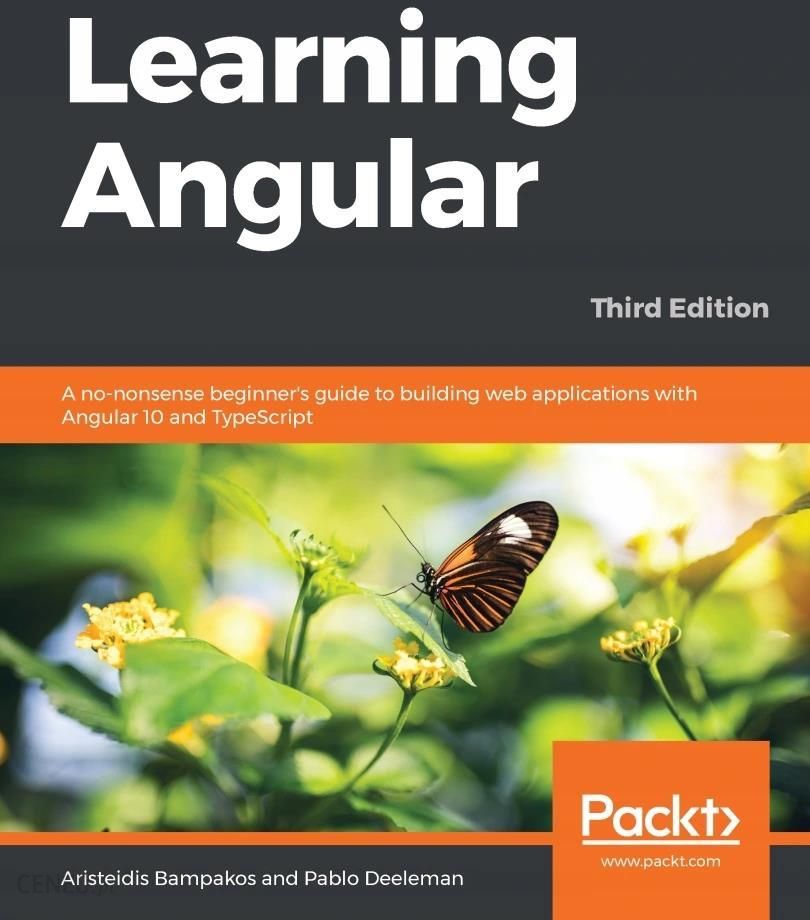Opis
Uncover Angulars potential for creating enterprise web applications—from setting up the environment to deployment—with the help of expert guidance, step-by-step explanations, and hands-on exercisesKey FeaturesLearn the fundamentals of Angular to build web applications using TypeScriptExplore the basics of Angular development, from components and templates to forms and servicesDiscover best practices for building, packaging, and testing Angular applicationsBook DescriptionAngular, loved by millions of web developers around the world, continues to be one of the top JavaScript frameworks thanks to its regular updates and new features that enable fast, cross-platform, and secure frontend web development. With Angular, you can achieve high performance using the latest web techniques and extensive integration with web tools and integrated development environments (IDEs).Updated to Angular 10, this third edition of the Learning Angular book covers new features and modern web development practices to address the current frontend web development landscape. If you are new to Angular, this book will give you a comprehensive introduction to help you get you up and running in no time. Youll learn how to develop apps by harnessing the power of the Angular command-line interface (CLI), write unit tests, style your apps by following the Material Design guidelines, and finally deploy them to a hosting provider. The book is especially useful for beginners to get to grips with the bare bones of the framework needed to start developing Angular apps.By the end of this book, youll not only be able to create Angular applications with TypeScript from scratch but also enhance your coding skills with best practices.What you will learnUse the Angular CLI to scaffold, build, and deploy a new Angular applicationBuild components, the basic building blocks of an Angular applicationDiscover techniques to make Angular components interact with each otherUnderstand the different types of templates supported by AngularCreate HTTP data services to access APIs and provide data to componentsEnhance your applications UX with Angular MaterialApply best practices and coding conventions to your large-scale web development projectsWho this book is forThe Angular TypeScript book is for JavaScript and full-stack developers who want to enter the world of frontend development with Angular or migrate to the Angular framework to build professional web applications. Familiarity with web and programming concepts will assist with understanding the content covered in the book. Spis treści:Learning Angular Third EditionWhy subscribe?ContributorsAbout the authorsAbout the reviewerPackt is searching for authors like youPrefaceWho this book is forWhat this book coversTo get the most out of this bookDownload the example code filesConventions usedGet in touchReviewsSection 1: Getting Started with AngularChapter 1: Building Your First Angular AppTechnical requirementsIts just Angular introducing semantic versioningPatch changeMinor changeMajor changeWhat about Angular?Introducing AngularSetting up our workspace with Angular CLIPrerequisitesInstalling Angular CLICLI commandsCreating a new projectHello AngularComponentsModulesSelectorTemplateBootstrappingIDEs and pluginsAtomSublime TextWebStormVisual Studio CodeSummaryChapter 2: Introduction to TypeScriptThe history of TypeScriptThe benefits of TypeScriptIntroducing TypeScript resourcesTypes in TypeScriptStringDeclaring variablesNumberBooleanArrayDynamic typing with any typeCustom typesEnumVoidType inferenceFunctions, lambdas, and execution flowAnnotating types in our functionsFunction parameters in TypeScriptArrow functionsCommon TypeScript featuresSpread parameterTemplate stringsGenericsClasses, interfaces, and inheritanceAnatomy of a classConstructor parameters with accessorsInterfacesClass inheritanceDecorators in TypeScriptClass decoratorsProperty decoratorsMethod decoratorsParameter decoratorAdvanced typesPartialRecordUnionNullableModulesSummarySection 2: Components the Basic Building Blocks of an Angular AppChapter 3: Component Interaction and Inter-CommunicationTechnical requirementsCreating our first componentComponent file creationModule registrationConfiguring a componentInteracting with the templateDisplaying data from the componentApplying styles to the templateGetting data from the templateCommunicating with other componentsPassing data using input bindingListening for events using output bindingLocal references in templatesEncapsulating CSS stylingChange detection strategiesIntroducing the component lifecyclePerforming component initializationCleaning up resourcesDetecting input changesSummaryChapter 4: Enhance Components with Pipes and DirectivesTechnical requirementsIntroducing directivesTransforming elements using directivesDisplaying data conditionallyIterating through dataSwitching through templatesManipulating data with pipesBuilding custom pipesSorting data using pipesChange detection with pipesBuilding custom directivesDisplaying dynamic dataProperty binding and responding to eventsToggling templates dynamicallySummaryChapter 5: Structure an Angular AppTechnical requirementsOrganizing components into modulesIntroducing Angular modulesCreating your first moduleRegistering components with a moduleExposing module featuresExtending functionality with modulesConfiguring the applicationConfiguring the workspaceDeveloping the applicationConfiguring the environmentHow dependency injection works in AngularDelegating complex tasks to servicesProviding dependencies across the applicationInjecting dependencies into the component treeOverriding providers in the injector hierarchySummaryChapter 6: Enrich Components with Asynchronous Data ServicesTechnical requirementsStrategies for handling asynchronous informationShifting from callback hell to promisesObservables in a nutshellReactive functional programming in AngularThe RxJS libraryCreating a backend API-the Angular wayCommunicating data over HTTPIntroducing the Angular HTTP clientHandling data with CRUD in AngularAuthenticating with HTTPHandling HTTP errorsUnsubscribing from observablesDestroying a componentUsing the async pipeSummarySection 3: User Experience and TestabilityChapter 7: Navigate through Components with RoutingTechnical requirementsIntroducing the Angular routerSpecifying a base pathImporting the router moduleConfiguring the routerRendering componentsCreating an Angular app with routingScaffolding an Angular app with routingAdding route configuration to our Angular appNavigating to application routesSeparating our app into feature routing modulesHandling unknown route pathsSetting a default pathNavigating imperatively to a routeDecorating router links with stylingPassing parameters to routesBuilding a detail page using route parametersReusing components using child routesTaking a snapshot of route parametersFiltering data using query parametersEnhancing navigation with advanced featuresControlling route accessPreventing navigation away from a routePreloading route dataLazy loading routesDebugging route configurationSummaryChapter 8: Orchestrating Validation Experiences in FormsTechnical requirementsIntroducing forms to web appsData binding with template-driven formsUsing reactive patterns in Angular formsTurning a template-driven form into a reactive oneProviding status feedbackCreating nesting form hierarchiesValidating controls in a reactive wayModifying forms dynamicallyCreating elegant reactive formsBuilding a custom validatorManipulating form dataWatching state changes and being reactiveSummaryChapter 9: Introduction to Angular MaterialTechnical requirementsIntroducing Material DesignKnown implementationsIntroducing Angular MaterialCreating your first Angular Material appAdding Angular Material controlsTheming Angular Material componentsAdding core UI controlsButtonsForm controlsNavigationLayoutPopups and modalsData tableIntroducing the Angular CDKClipboardDrag and dropDesigning layouts using flexboxSummaryChapter 10: Giving Motion to Components with AnimationsTechnical requirementsCreating animations with plain vanilla CSSIntroducing Angular animationsCreating our first animationAnimation callbacksAnimating components programmaticallyCreating a reusable animation directiveSummaryChapter 11: Unit test an Angular AppTechnical requirementsWhy do we need tests?The anatomy of a unit testIntroducing unit tests in AngularConfiguring Karma as the test runnerAngular testing utilitiesTesting componentsTesting with dependenciesTesting with inputs and outputsTesting servicesTesting a synchronous methodTesting an asynchronous methodTesting services with dependenciesTesting pipesTesting routingTesting the navigation URLTesting route parametersTesting routesTesting directivesTesting reactive formsSummarySection 4: Deployment and PracticeChapter 12: Bringing an Angular App to ProductionTechnical requirementsBuilding an Angular appLimiting the application bundle sizeOptimizing the application bundleDeploying an Angular appSummaryChapter 13: Develop a Real-World Angular AppTechnical requirementsScaffolding the application structureImplementing core featuresPersisting data using local storageCreating a header componentAdding heroes functionalityAdding a new heroDisplaying a list of heroesTaking actions on a specific heroIntegrating the missions moduleAssigning a new missionMarking a mission as completedSummaryOther Books You May EnjoyLeave a review – let other readers know what you think
Kategoria: E-Beletrystyka
Producent:
kot birmański, mała syrenka 2, mapa szlaki, antygona opracowanie
yyyyy






